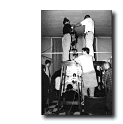|
 |
||
| Never work with children and animals goes the saying... but courageous Audrey O'Reilly has just directed a graduation film based on her childhood experiences of hospital. Avril O'Reilly recounts the experience |
DAY ONE
If the soldiers at St. Bricin's Military Hospital in Dublin are surprised at the sight in their emergency ward, then they don't show it. The ward, which was empty the day before, is packed to bursting point with bruised, scarred and burnt children. Clad in nighties and teddy bear pyjamas they are awaiting instructions from the person responsible for the carnage. Audrey O'Reilly, is directing a film based on her childhood experiences of hospital.
The soldiers' indifference is understandable. Compared with the likes of Jim Sheridan, Daniel Day-Lewis and a full complement of Spice Girls - all of whom have filmed in St Bricins - a "final year" film, even if it is from Ireland's most prestigious film school, Dun Laoghaire College, is no big deal. For Audrey and her crew it is an extremely big deal.
Finishing this 20 minute film in a week requires that the crew rise at six thirty every morning and work until late into the night. It is hoped that the cast of (unpaid) small children will share that work ethic. They'd better. The film won't get made otherwise.
Our heroine is Ali, played by Maeve. Ali is teased at home and at school because of her kidney problem but on the children's ward the seriousness of her complaint makes her Queen Bee. Maeve- nine going on forty, actress going on studio head - grasps her role instantly. She sneers at cry-baby tonsillitis patients, she guilt trips her visitors and she still has time to tell the continuity man exactly which page her Beano comic was open on. Looks, talent and a lengthy concentration span. What more could we ask for?
DAY TWO
It is the mixed doubles effect. It has often been noted that when serious players step on court for a doubles game, grim seriousness is replaced by jovial bottom slapping and general playfulness. So it is when Anthea arrives to play Sarah, Ali's best friend. We watch in horror as professional Maeve turns into a giddy little girl. What they don't tell you is that the heady pleasure of each other's company goes to children's heads far quicker than sugar. The problem is solved by putting Maeve in charge of giving Anthea her directions. Anthea responds to the serious mood by suggesting improvisations. Not for the last time anarchy is held at bay.
Hughie is playing a reluctant patient arriving in the ward. Unfortunately, at the last minute his natural ability to scream seems to have deserted him, leaving him capable only of small choked 'aaak' sounds. Tutorials from Audrey follow. "Copy me" she instructs and launches into a series of escalating screams. Each shriek is distressingly louder than the last - adult crew members are seen to jump - and Hughie bravely copies each one. He finishes with an impressive yell. The crew's well intentioned round of applause is the straw that breaks the camel's back. Hughie bursts into genuine tears (surreptitiously captured by a resourceful camera woman.)
DAY THREE
When four year old Sean suddenly becomes camera shy, Audrey uses the peer role model approach, combined with some traditional boy/girl psychology to get him to cry "You can do better than these girls, can't you?" is the challenge followed by Maeve and Anthea demonstrating just what girls can do. Like terror and fury personified the two show the extent to which vocal and physical protest can be used to avoid getting into a hospital bed. Was Sean impressed, motivated, galvanised? In fact, no. Tears are streaming down his horrified face and his fingers are firmly embedded in his mum's thigh. Her reassurances that "It's OK to cry" seem a little redundant.
Nonetheless the job has to be done. Sean wants out at the end of every take but a pep talk from his mum is enough to buoy him up to go out and do it again and again and (oh bugger, hair in the gate) again...
DAY FOUR...
DAY FIVE...
DAY SIX...
DAY SEVEN...
Post Script...
Full article published in Filmwaves - Issue 6, Winter 1999. Subscribe now!
